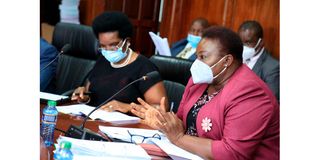More men than women got promotions in civil service last year

Public Service PS Mary Kimonye (left) and NYS boss Matildah Sakwa during a PAC hearing at Parliament Buildings on February 16.
What you need to know:
- A report by the Public Service Commission tabled in the Senate shows more male employees in the public service were promoted in the 2020/2021 financial year than their female counterparts.
- Appearing before the Senate’s Cohesion and Equal Opportunities Committee, Public Service PS Mary Kimonye, said the promotions were meant to address succession gaps in State agencies.
More male employees in the public service were promoted in the 2020/2021 financial year than their female counterparts, says a report by the Public Service Commission (PSC) tabled in the Senate yesterday.
Of the 7,415 officers who rose in rank, 4,431 (60 per cent) were men while only 2,984 (40 per cent) were women, while 49 (0.75 per cent) were people with disabilities.
Appearing before the Senate’s Cohesion and Equal Opportunities Committee, Public Service Principal Secretary Mary Kimonye, said the promotions were meant to address succession gaps in State agencies.
High staff turn over
“The promotions are intended to address staffing gaps in the grading structures, aging workforce, stagnation of staff, mismatch of skills and jobs, high staff turnover in some key cadres and shortage of relevant skills and competences,” she said.
“In appointing persons to hold public offices, the commission ensures fair competition and merit as the basis of appointments and promotions.”
The report presented by Ms Kimonye indicates that in 2020/2021, a total of 5,324 new employees below the age of 35 were recruited in the public service. Of those, 2,521 were men while 2,803 were women. Some 132 were people with disabilities while 1,309 were from marginalised and minority groups.
Delegated authority
In the same period, 3,198 officers were recruited into State agencies “under delegated authority”. Out of that number, 1,594 were female while 1,604 were male. Recruitment under delegated authority is where staff already in employment in different agencies are promoted by senior officers in the organisation.
The document shows that, in entry-level appointments, the number of people with disabilities rose from 1.5 per cent to 1.8 per cent. The number of new entrants who were women also rose from 42.7 per cent to 52 per cent while that of men dropped from 57.3 per cent to 48 per cent.
“The public service has made great strides in implementing the constitutional requirement for fair competition and merit, representation of diverse communities and affording equal employment to men and women, members of all ethnic groups and persons with disabilities,” Ms Kimonye said.
Vernacular stations
In order to ensure progressive and proportionate representation of the various groups in the public service, she said, PSC will enhance advertisements of government jobs to vernacular stations.
But PSC failed to provide a comprehensive list of all chief executive officers serving in the 286 parastatals. Ms Kimonye said the database is maintained by the State Corporation Advisory Committee and the list is still being compiled.
The PS was invited to explain the unfair distribution of top positions in parastatals, with only two communities dominating according to a report presented in Parliament last year.
Ms Kimonye is expected to appear before the committee again in two weeks.





